Mask Generation
Mask generation is the task of generating masks that identify a specific object or region of interest in a given image. Masks are often used in segmentation tasks, where they provide a precise way to isolate the object of interest for further processing or analysis.


About Mask Generation
Use Cases
Filtering an Image
When filtering for an image, the generated masks might serve as an initial filter to eliminate irrelevant information. For instance, when monitoring vegetation in satellite imaging, mask generation models identify green spots, highlighting the relevant region of the image.
Masked Image Modelling
Generating masks can facilitate learning, especially in semi or unsupervised learning. For example, the BEiT model uses image-mask patches in the pre-training.
Human-in-the-loop Computer Vision Applications
For applications where humans are in the loop, masks highlight certain regions of images for humans to validate.
Medical Imaging
Mask generation models are used in medical imaging to aid in segmenting and analyzing specific regions.
Autonomous Vehicles
Mask generation models are used to create segments and masks for obstacles and other objects in view.
This page was made possible thanks to the efforts of Raj Aryan and other contributors.
Task Variants
Segmentation
Image Segmentation divides an image into segments where each pixel is mapped to an object. This task has multiple variants, such as instance segmentation, panoptic segmentation, and semantic segmentation. You can learn more about segmentation on its task page.
Inference
Mask generation models often work in two modes: segment everything or prompt mode. The example below works in segment-everything-mode, where many masks will be returned.
from transformers import pipeline
generator = pipeline("mask-generation", model="Zigeng/SlimSAM-uniform-50", points_per_batch=64, device="cuda")
image_url = "https://huggingface.co/ybelkada/segment-anything/resolve/main/assets/car.png"
outputs = generator(image_url)
outputs["masks"]
# array of multiple binary masks returned for each generated mask
Prompt mode takes in three types of prompts:
- Point prompt: The user can select a point on the image, and a meaningful segment around the point will be returned.
- Box prompt: The user can draw a box on the image, and a meaningful segment within the box will be returned.
- Text prompt: The user can input a text, and the objects of that type will be segmented. Note that this capability has not yet been released and has only been explored in research.
Below you can see how to use an input-point prompt. It also demonstrates direct model inference without the pipeline abstraction. The input prompt here is a nested list where the outermost list is the batch size (1), then the number of points (also 1 in this example), and the innermost list contains the actual coordinates of the point ([450, 600]).
from transformers import SamModel, SamProcessor
from PIL import Image
import requests
model = SamModel.from_pretrained("Zigeng/SlimSAM-uniform-50").to("cuda")
processor = SamProcessor.from_pretrained("Zigeng/SlimSAM-uniform-50")
raw_image = Image.open(requests.get(image_url, stream=True).raw).convert("RGB")
# pointing to the car window
input_points = [[[450, 600]]]
inputs = processor(raw_image, input_points=input_points, return_tensors="pt").to("cuda")
outputs = model(**inputs)
masks = processor.post_process_masks(outputs.pred_masks.cpu(), inputs["original_sizes"].cpu(), inputs["reshaped_input_sizes"].cpu())
scores = outputs.iou_scores
Useful Resources
Would you like to learn more about mask generation? Great! Here you can find some curated resources that you may find helpful!
Compatible libraries
No example widget is defined for this task.
Note Contribute by proposing a widget for this task !
Note Small yet powerful mask generation model.
Note Very strong mask generation model.
Note Medical Imaging dataset of the Human Brain for segmentation and mask generating tasks
Note An application that combines a mask generation model with a zero-shot object detection model for text-guided image segmentation.
Note An application that compares the performance of a large and a small mask generation model.
Note An application based on an improved mask generation model.
Note An application to remove objects from videos using mask generation models.
- Intersection over Union (IoU)
- IoU is used to measure the overlap between predicted mask and the ground truth mask.